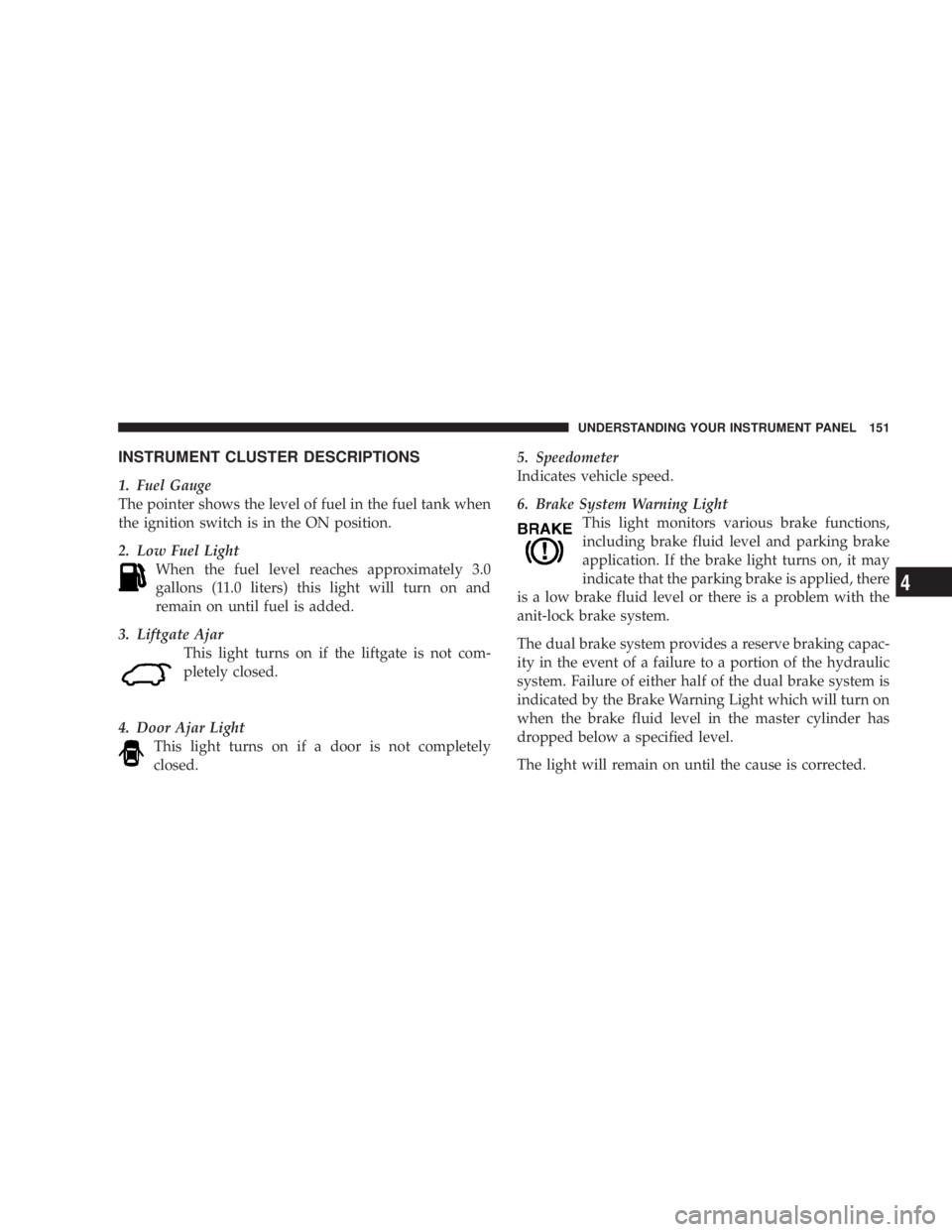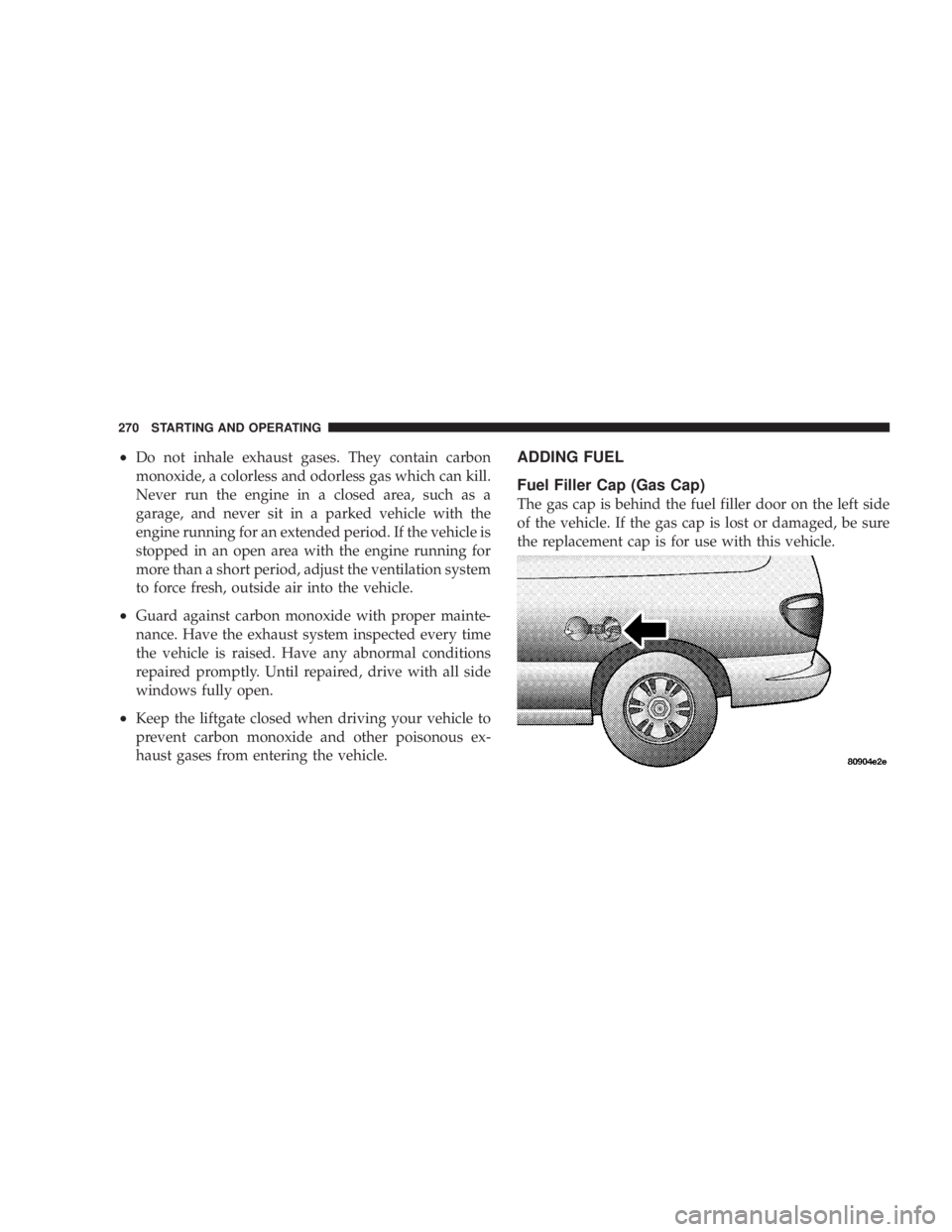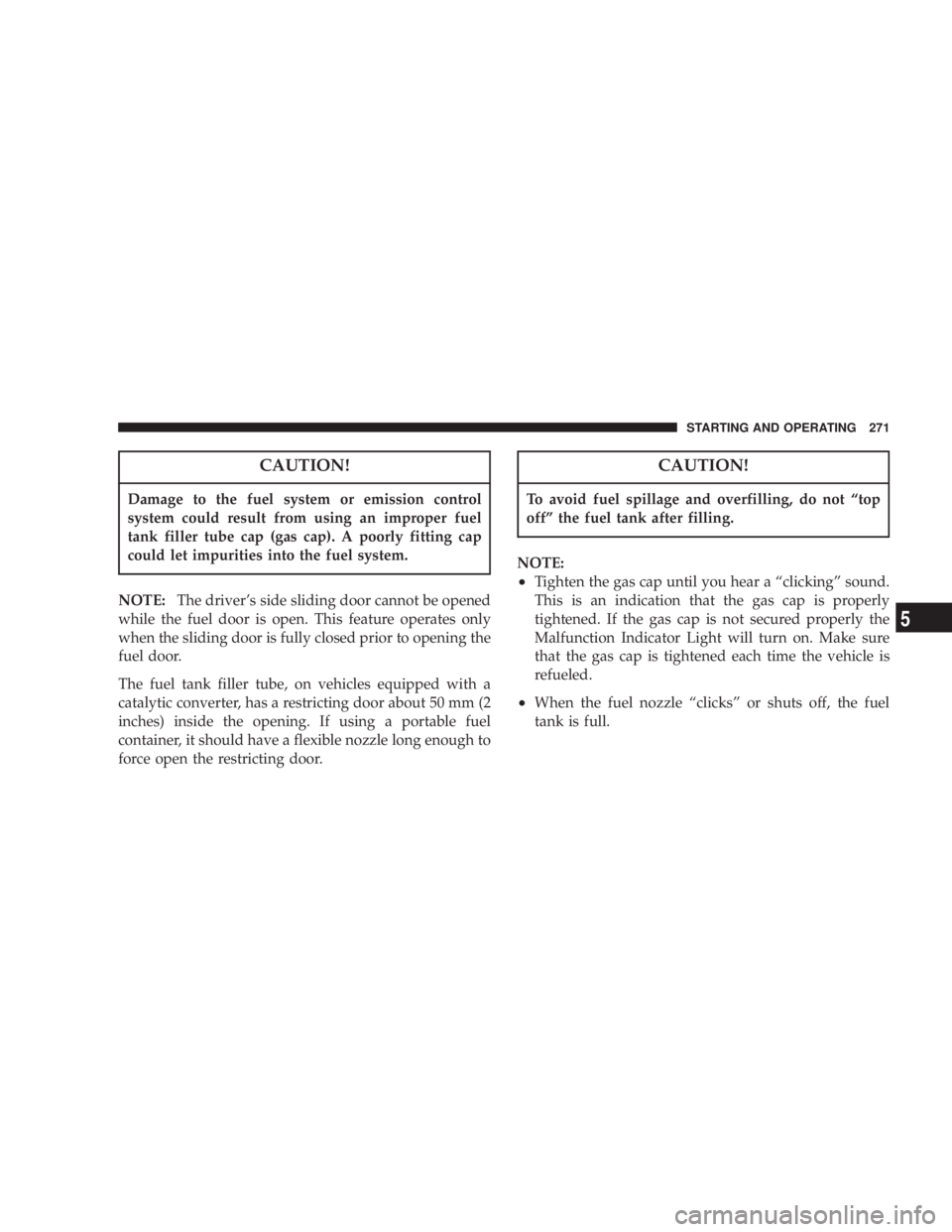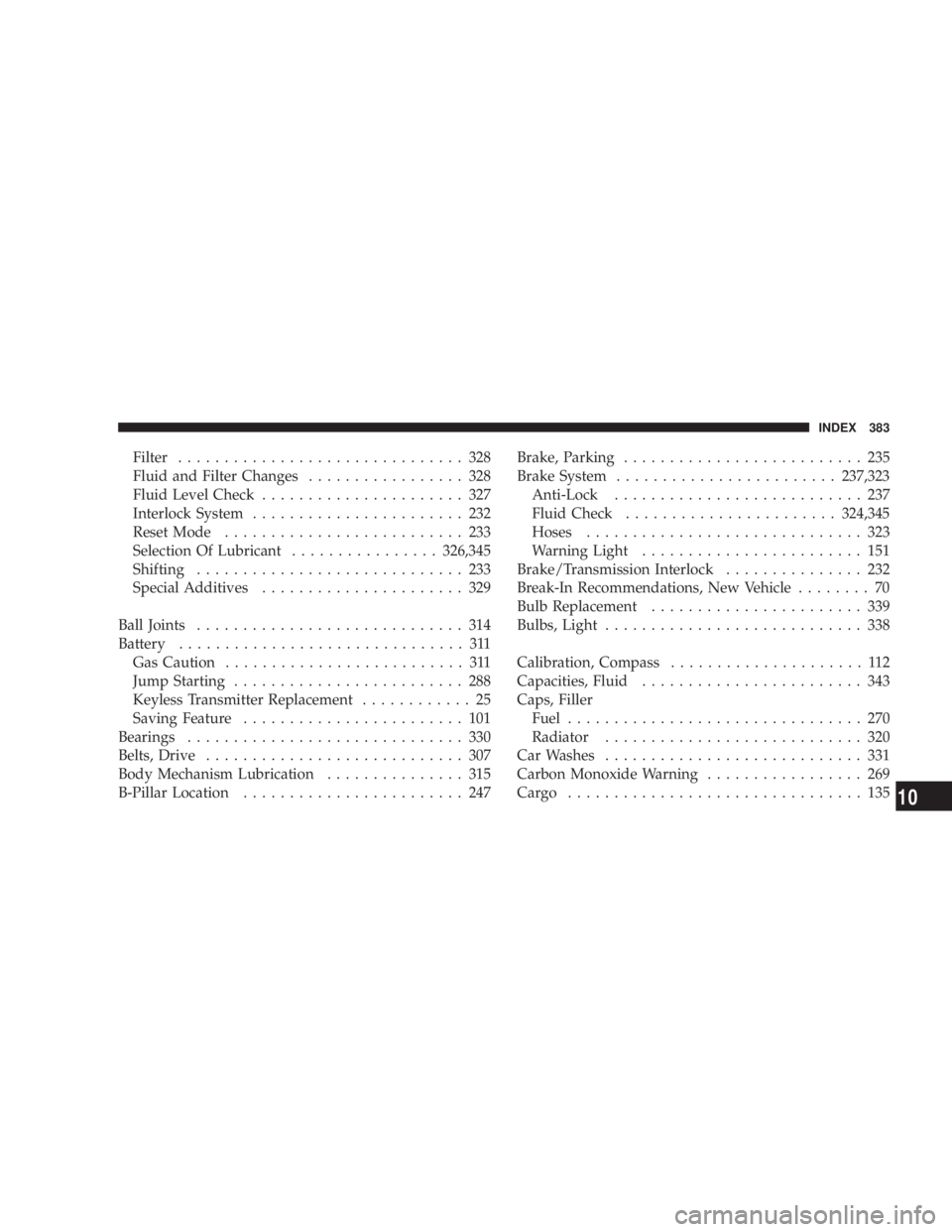Page 151 of 397

INSTRUMENT CLUSTER DESCRIPTIONS
1. Fuel Gauge
The pointer shows the level of fuel in the fuel tank when
the ignition switch is in the ON position.
2. Low Fuel Light
When the fuel level reaches approximately 3.0
gallons (11.0 liters) this light will turn on and
remain on until fuel is added.
3. Liftgate Ajar
This light turns on if the liftgate is not com-
pletely closed.
4. Door Ajar Light
This light turns on if a door is not completely
closed. 5. Speedometer
Indicates vehicle speed.
6. Brake System Warning Light
This light monitors various brake functions,
including brake fluid level and parking brake
application. If the brake light turns on, it may
indicate that the parking brake is applied, there
is a low brake fluid level or there is a problem with the
anit-lock brake system.
The dual brake system provides a reserve braking capac-
ity in the event of a failure to a portion of the hydraulic
system. Failure of either half of the dual brake system is
indicated by the Brake Warning Light which will turn on
when the brake fluid level in the master cylinder has
dropped below a specified level.
The light will remain on until the cause is corrected. UNDERSTANDING YOUR INSTRUMENT PANEL 151
4
Page 155 of 397

WARNING!A hot engine cooling system is dangerous. You or
others could be badly burned by steam or boiling
coolant. You may want to call a service center if your
vehicle overheats. If you decide to look under the
hood yourself, see Section 7 of this manual. Follow
the warnings under the Cooling System Pressure
Cap paragraph.
15. Washer Fluid Light
This light turns on when the washer fluid level
falls below approximately 1/4 filled. The light will
remain on until fluid is added.
16. Transmission Range Indicator
This vacuum fluorescent display indicator shows the
automatic transaxle gear selection. 17. Oil Pressure Warning Light
This light shows low engine oil pressure. The light
should turn on momentarily when the engine is
started. If the light turns on while driving, stop the
vehicle and shut off the engine as soon as possible. A
chime will sound for 4 minutes when this light turns on.
Do not operate the vehicle until the cause is corrected.
This light does not show how much oil is in the engine.
The engine oil level must be checked under the hood.
18. Malfunction Indicator Light
This light is part of an onboard diagnostic system
called OBD that monitors engine and automatic
transmission control systems. The light will illu-
minate when the key is in the ON position before engine
start. If the bulb does not come when turning the key
from OFF to ON, have the condition checked promptly.
Certain conditions such as a loose or missing gas cap,
poor fuel quality, etc. may illuminate the light after UNDERSTANDING YOUR INSTRUMENT PANEL 155
4
Page 225 of 397
N Gasoline/Oxygenate Blends ..............267
N MMT In Gasoline .....................267
N Sulfur In Gasoline .....................268
N Materials Added To Fuel ................268
N Fuel System Cautions ..................269
N Carbon Monoxide Warnings ..............269
m Adding Fuel ..........................270
N Fuel Filler Cap (Gas Cap) ...............270 m Vehicle Loading ........................272
N Vehicle Certification Label ...............272
N Gross Vehicle Weight Rating (GVWR) .......273
N Gross Axle Weight Rating (GAWR) .........273
N Overloading .........................273
N Loading ............................274
m Trailer Towing .........................275
N Warranty Requirements .................275 STARTING AND OPERATING 225
5
Page 270 of 397

² Do not inhale exhaust gases. They contain carbon
monoxide, a colorless and odorless gas which can kill.
Never run the engine in a closed area, such as a
garage, and never sit in a parked vehicle with the
engine running for an extended period. If the vehicle is
stopped in an open area with the engine running for
more than a short period, adjust the ventilation system
to force fresh, outside air into the vehicle.
² Guard against carbon monoxide with proper mainte-
nance. Have the exhaust system inspected every time
the vehicle is raised. Have any abnormal conditions
repaired promptly. Until repaired, drive with all side
windows fully open.
² Keep the liftgate closed when driving your vehicle to
prevent carbon monoxide and other poisonous ex-
haust gases from entering the vehicle. ADDING FUEL
Fuel Filler Cap (Gas Cap)
The gas cap is behind the fuel filler door on the left side
of the vehicle. If the gas cap is lost or damaged, be sure
the replacement cap is for use with this vehicle.270 STARTING AND OPERATING
Page 271 of 397

CAUTION!Damage to the fuel system or emission control
system could result from using an improper fuel
tank filler tube cap (gas cap). A poorly fitting cap
could let impurities into the fuel system.
NOTE: The driver's side sliding door cannot be opened
while the fuel door is open. This feature operates only
when the sliding door is fully closed prior to opening the
fuel door.
The fuel tank filler tube, on vehicles equipped with a
catalytic converter, has a restricting door about 50 mm (2
inches) inside the opening. If using a portable fuel
container, it should have a flexible nozzle long enough to
force open the restricting door. CAUTION!To avoid fuel spillage and overfilling, do not ªtop
offº the fuel tank after filling.
NOTE:
² Tighten the gas cap until you hear a ªclickingº sound.
This is an indication that the gas cap is properly
tightened. If the gas cap is not secured properly the
Malfunction Indicator Light will turn on. Make sure
that the gas cap is tightened each time the vehicle is
refueled.
² When the fuel nozzle ªclicksº or shuts off, the fuel
tank is full. STARTING AND OPERATING 271
5
Page 272 of 397

WARNING!² Remove the fuel tank filler tube cap (gas cap) slowly
to prevent fuel spray from the filler neck which may
cause injury.
² The volatility of some gasolines may cause a buildup
of pressure in the fuel tank that may increase while
you drive. This pressure can result in a spray of
gasoline and/or vapors when the cap is removed
from a hot vehicle. Removing the cap slowly allows
the pressure to vent and prevents fuel spray.
² Never have any smoking materials lit in or near the
vehicle when the gas cap is removed or the tank
filled.
² Never add fuel to the vehicle when the engine is
running.
² A fire may result if gasoline is pumped into a
portable container that is inside of a vehicle. You
could be burned. Always place gas containers on the
ground while filling. VEHICLE LOADING
The load carrying capacity of your vehicle is shown in the
charts that follow. This information should be used for
passenger and luggage loading as indicated.
If seats are removed for carrying cargo, do not exceed the
specified GVWR and GAWR.
Vehicle Certification Label
Your vehicle has a certification label attached to the
driver's door pillar.
The label contains the following information:
² Name of manufacturer
² Month and year of manufacture
² Gross Vehicle Weight Rating (GVWR)
² Gross Axle Weight Rating (GAWR) front
² Gross Axle Weight Rating (GAWR) rear272 STARTING AND OPERATING
Page 343 of 397
Center High Mounted Stop Light (CHMSL)
1. Remove the two screws securing the CHMSL.
2. Twist the bulb socket to remove from the CHMSL
housing.
3. Pull the bulb out of the socket.
4. Replace the bulb, reinstall the socket and reattach the
CHMSL. License Light
1. Remove the two lens assembly mounting screws.
2. Pull the bulb out of the socket. Replace the bulb and
reattach the lens assembly.
FLUID CAPACITIES
U.S. Metric
Fuel (Approximate) 20 Gallons 76 Liters
Engine Oil-with filter
2.4 Liter Engine 5.0 qts 4.7 Liters
3.3 & 3.8 Liter Engines 5.0 qts 4.7 Liters
Cooling System *
2.4 Liter Engines 11.4 qts 10.7 Liters
² 3.3 & 3.8 Liter Engines 13.4 qts 12.6 Liters
* Includes heater and coolant recovery bottle filled to
MAX level.
² * Add 2.9 quarts (2.8 liters) if equipped with a rear
heater. MAINTAINING YOUR VEHICLE 343
7
Page 383 of 397

Filter ............................... 328
Fluid and Filter Changes ................. 328
Fluid Level Check ...................... 327
Interlock System ....................... 232
Reset Mode .......................... 233
Selection Of Lubricant ................ 326,345
Shifting ............................. 233
Special Additives ...................... 329
Ball Joints ............................. 314
Battery ............................... 311
Gas Caution .......................... 311
Jump Starting ......................... 288
Keyless Transmitter Replacement ............ 25
Saving Feature ........................ 101
Bearings .............................. 330
Belts, Drive ............................ 307
Body Mechanism Lubrication ............... 315
B-Pillar Location ........................ 247 Brake, Parking .......................... 235
Brake System ........................ 237,323
Anti-Lock ........................... 237
Fluid Check ....................... 324,345
Hoses .............................. 323
Warning Light ........................ 151
Brake/Transmission Interlock ............... 232
Break-In Recommendations, New Vehicle ........ 70
Bulb Replacement ....................... 339
Bulbs, Light ............................ 338
Calibration, Compass ..................... 112
Capacities, Fluid ........................ 343
Caps, Filler
Fuel ................................ 270
Radiator ............................ 320
Car Washes ............................ 331
Carbon Monoxide Warning ................. 269
Cargo ................................ 135 INDEX 383
10